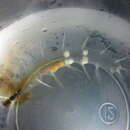en
names in breadcrumbs


"Flota flabelligera, new species
(Plate 38)
Records: 2:4 sta. 190 (10+, TYPE); 2:5 sta. 175 (2) ; 5:6 sta. 315 (1).
Description: All specimens come from pelagic samples and are macerated and frayed. The best preserved, from sta. 190, are completely encased in thick, hyaline sheaths (Fig. B) ; they lack color except for the black alimentary tract seen through the anterior half of the body. Length is 23 to 25 mm; width without the mucus sheath is 6 to 8 mm, and segments number 9. The first parapodia are longest and directed obliquely forward (Fig. A); others are directed laterally. The mucoid sheath is so intimately connected with the body that its removal results in tearing away many of the surface papillae and setal tips. Some individuals have the pharyngeal apparatus partly or wholly everted; it consists of a thick, muscular sac, subcircular in retraction and filling most of the body cavity in the first segment; it is long, shovel-like when everted, with the sides prolonged upward and open dorsally. The pale proboscis is replaced farther back by a black, slender, wrinkled glandular pharynx which extends through two segments (retracted) and then abruptly narrows into a slender, cylindrical black tube in the fourth and fifth segments. The alimentary tract is white, thin-walled and irregularly wound in the second half of the body; septal walls are indicated only in the transverse lines on the surface of the epithelium.
The prostomium, best seen when the pharynx is not everted, is bluntly conical ; it has a pair of laterally attached trilobed structures, which may represent a pair of shorter palpi, and two pairs of branchiae, corresponding to those in typical, benthic members of this family; there are no visible eves or other pigmented spots on the prostomium.
The dorsoventrally flattened body is externally biannulate, with each segment crossed by two transverse ridges; on its ventral side it has conspicuous paired projecting neural nodes, a pair to a segment.
The first parapodia are largest, transversely wrinkled as though greatly extensile; setae project distally from the ends of the lobe only slightly, but their embedded ends are long ; they number 20 or more in a close fascicle. Each ramus has one or a few thicker, transversely barred setae which project beyond the outer mucoid sheath. Para-podia of more posterior segments are similar to those in front, but have shorter setae. Two pairs of long, digitate papillae resembling cirri project from between the third and fourth and the fourth and fifth segments; they represent nephridial tubes.
Epithelial papillae are of two kinds; the dorsum has numerous, short stalked or nearly sessile, subglobular papillae strewn over the surface and most concentrated about the parapodia ; the distal ends of notopodia have many closely set, long-stemmed papillae with distal bulb, extending through the mucus sheath ; some of the stalks have spent ends, as though they may be excreting organs, resembling those described for Flabelligera essenbergae Hartman (1961, p. 118).
Rota flabelligera is clearly allied with the flabelligerids, even though the habitat is pelagic, a cephalic cage is lacking, and the prostomial structures are modified. The biramous parapodia have setae, some of which are characteristically cross-barred. The mucoid sheath is characteristic of an aberrant annelid Poeobius meseres Heath, which has a similar mode of life; the affinities of Poeobius to the flabelligerids has been suggested (Hartman, 1955, p. 52).
Through the kindness of Dr. J. van der Land of the Rijksmuseum of the Netherlands, my attention has been called to another pelagic flabelligerid-like polychaete from the Bay of Guayaquil, Ecuador. This species was briefly characterized and named Enigma terwielii Betrem (1924, p. xcix). Dr.J. G. Betrem, now at Cornell University, has verified the correctness of the locality and reported the type collection lost. I am indebted to Dr. van der Land for a translation of the original description:
"The surface epithelium has papillae and the body is embedded in a hyaline mass. Parapodia and setae are absent. The prostomium has branchial filaments and a pair of palpi, both retractile into the anterior end. The nervous system has a single median, ganglionated cord. The intestine is red in life and coiled. There are 2 pairs of excretory organs, one in the anterior, the other in the posterior part of the body; they lack ciliated funnels. The dorsal blood vessel is accompanied by a cardiac body over the oesophagus. A single septum is present. The unpaired gonad lies close to the intestinal coil."
The total lack of setae places this form nearer to Poeobius meseres Heath than to Flota finbelligera.
Distribution: Flota finbelligera has been taken only off southwest Chile, in 365 over 3623 m, and in 2891 over 4008-4110 m; also off Cape Horn, in 3770-3806 m."
(Hartman, 1965)